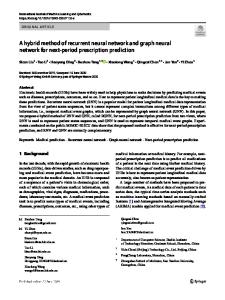Interpretable clinical prediction via attention-based neural network
- PDF / 1,157,562 Bytes
- 9 Pages / 595.276 x 790.866 pts Page_size
- 6 Downloads / 289 Views
RESEARCH
Open Access
Interpretable clinical prediction via attention-based neural network Peipei Chen1,2, Wei Dong3, Jinliang Wang4, Xudong Lu1,2, Uzay Kaymak2,1 and Zhengxing Huang1* From 5th China Health Information Processing Conference Guangzhou, China. 22-24 November 2019
Abstract Background: The interpretability of results predicted by the machine learning models is vital, especially in the critical fields like healthcare. With the increasingly adoption of electronic healthcare records (EHR) by the medical organizations in the last decade, which accumulated abundant electronic patient data, neural networks or deep learning techniques are gradually being applied to clinical tasks by utilizing the huge potential of EHR data. However, typical deep learning models are black-boxes, which are not transparent and the prediction outcomes of which are difficult to interpret. Methods: To remedy this limitation, we propose an attention neural network model for interpretable clinical prediction. In detail, the proposed model employs an attention mechanism to capture critical/essential features with their attention signals on the prediction results, such that the predictions generated by the neural network model can be interpretable. Results: We evaluate our proposed model on a real-world clinical dataset consisting of 736 samples to predict readmissions for heart failure patients. The performance of the proposed model achieved 66.7 and 69.1% in terms of accuracy and AUC, respectively, and outperformed the baseline models. Besides, we displayed patient-specific attention weights, which can not only help clinicians understand the prediction outcomes, but also assist them to select individualized treatment strategies or intervention plans. Conclusions: The experimental results demonstrate that the proposed model can improve both the prediction performance and interpretability by equipping the model with an attention mechanism. Keywords: Interpretability, Attention mechanism, Clinical prediction, Deep learning
Background Recently, deep learning techniques have achieved great success in healthcare domain due to their impressive performance [1–3]. Specifically, with the increasingly adoption of electronic healthcare records (EHR) by the medical organizations in the last decade, a large volume of electronic patient data is accumulated, and thereafter * Correspondence: [email protected] 1 College of Biomedical Engineering and Instrumental Science, Zhejiang University, Hangzhou, China Full list of author information is available at the end of the article
neural networks or deep learning techniques are gradually being applied to clinical prediction tasks by utilizing the huge potential of EHR data, e.g. clinical risk assessment, outcome prediction, treatment effect estimation and treatment recommendations [4–7]. However, typical deep learning models are blackboxes, which are not transparent and the prediction outcomes of which are difficult to interpret [8]. Therefore, although deep learning models have shown remarkab
Data Loading...











